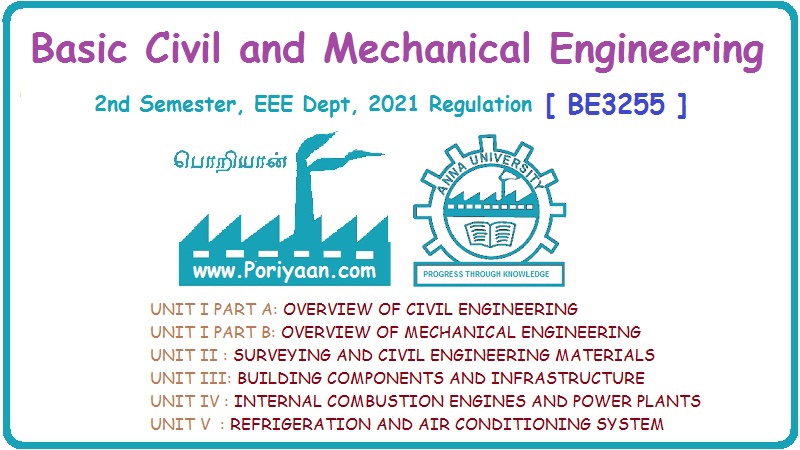Basic Civil & Mechanical Engineering: UNIT II: p. Timber
Timber based products
The demand for good varieties of timber like teak, deodar, sal, sissoo, etc., is so high that Indian forests are unable to meet it.
TIMBER BASED PRODUCTS
The
demand for good varieties of timber like teak, deodar, sal, sissoo, etc., is so
high that Indian forests are unable to meet it. Timber-based products make
lesser known species to meet the demand equally well. The common industrial-based
timber products are briefed below:
1. VENEERS
Veneers
are thin sheets of superior quality woods of 0.4-6 mm thickness. Teak, rosewood
and sissoo yield good veneers. These good quality woods are cut into logs of
1.5-2.5 m length and steamed. They are then cut into thin sheets by rotary saw
or by slicing manually.
2. PLYWOOD
Plywood
is made by gluing thin layers of wood or veneers. The number of veneers is
always odd. The directions of veneers in successive layers are kept at right
angles to each other in order to achieve good strength in all directions. The
outside layers are called faces, while the central portion is called the core
and others are called cross-bands. In order to have a good appearance and to
maintain economy, one face of the veneer is of very good quality while the bulk
is of ordinary quality.
Plywoods
are of the following types:
•
Ordinary grade, used as a packing material.
•
Exterior grade, made of good quality wood and bonded with waterproof glue.
•
Marine grade, in which the core and exterior are of superior quality.
The
thicknesses of plywood boards are as given below:
(i)
3 ply – 3,4,5,6 mm
(ii)
5 ply – 5,6,8,9 mm
(iii) 7 ply - 9,12,15,16 mm
(iv)
9 ply – 12,15,16,19 mm
(v)
11 ply - 19,22,25 mm
(vi)
More than 11 ply - as per order
3. PARTICLE BOARD
Particle
board is made from chips of wood, rice husk or bagasse obtained after crushing
sugarcane. Using automatic driers, the moisture content of these wood wastes is
reduced to 15% and they are sprayed with gluing material like formaldehyde.
This adhesive-coated material is spread in three layers along with a resin mix.
The
middle layer usually consists of coarser particles. The outer layer consists of
finer particles and higher resin content. The mat is then pressed in the
presence of heat. Hydraulic presses are used for this process. Particle boards
of various sizes are manufactured where the thickness is the range of 6 to 40
mm.
4. FIBRE BOARDS
For
making fibre boards, wooden chips and vegetable fibres are placed in boiling
water till wood fibres separate. These fibres are blended with resin and steam
under pressure. Steam pressure is raised for a few seconds and then released.
These wood fibres are allowed to flow out and are cleaned. The fibres are then
spread in the form of sheets. They are machine pressed under controlled heat
and pressure.
5. HARDBOARD
Hardboard
is made from wood and wood waste, which is pulped and mixed with
water-repellent agents like paraffin wax and resins like phenol formaldehyde.
The fibres so formed are wet felted or dry felted. In wet felting, a mat is
formed from a low consistency felt and initially cold pressed, and then hot
pressed. In case of dry felting, relatively dry fibres are pressed by air or
mechanical means. Hardboards are of three types, viz., medium, standard and
tempered.
6. BLOCK BOARD
Block
boards are known as batten boards and also as solid core plywood. The core
consists of strips of wood of width 25-80 mm glued to form a slab. Veneers are
glued on either side, and these may be in single or multiple layers. The
thickness of a veneer is 0.5-1.5 mm. The veneers shall be of ornamental
quality, either on one or both sides. The total thickness of these boards is 18
mm and above. Grade I quality block boards are used for building the bodies of
buses and railway coaches. Grade II quality boards are used for making
partitions and furniture.
7. GLULAM
de
Glued laminated timber is called glulam. It is a type of structural timber
product made up of several layers of timber bonded together with adhesive. It
is made of solid wood without the use of veneers. The timber sections are
joined with the help of glue. It is used for making long-span beams and trusses
for long-span column free roofs. The above timber-based products offer the
following advantages:
1.
Many secondary species of timber and all kinds of wood waste can be utilized.
2.
The products are adequately strong in all directions and their shrinkage is
less due to cross-grained production.
3.
They can be made functionally superior by giving plastic coating.
4.
They have better insulation properties.
5.
Their aesthetic appeal can be enhanced.
Basic Civil & Mechanical Engineering: UNIT II: p. Timber : Tag: : - Timber based products
Related Topics
Related Subjects
Basic Civil and Mechanical Engineering
BE3255 2nd Semester 2021 Regulation | 2nd Semester EEE Dept 2021 Regulation
